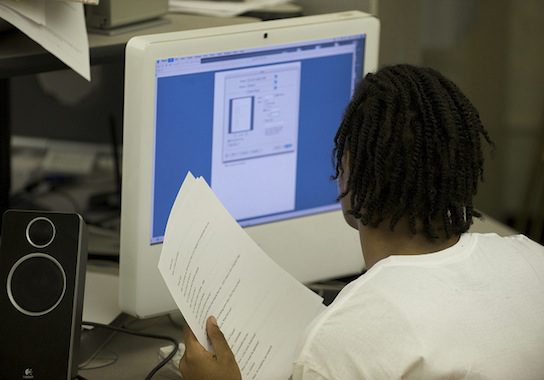The “Connected” Classroom and Its Limits

As schools consider necessary educational reforms and incentives, decisions on digital media’s use and purpose in the classroom are becoming more important than ever. President Obama proposed a ConnectED program in June to bring high-speed broadband and wireless to schools across the U.S. “We are living in a digital age, and to help our students get ahead, we must make sure they have access to cutting-edge technology,” he said.
It is true that technology has many educational uses. Google and Bing, JSTOR and LexisNexis, ILL’s and online libraries are just a few excellent research tools offered by the Internet. But digital media offers as many educational concerns as it does benefits. Tim Wu pointed perhaps the greatest disadvantage in a New Yorker piece this week:
Today’s machines don’t just allow distraction; they promote it. The Web calls us constantly, like a carnival barker, and the machines, instead of keeping us on task, make it easy to get drawn in—and even add their own distractions to the mix. In short: we have built a generation of ‘distraction machines’ that make great feats of concentrated effort harder instead of easier.
Children and young adults are often tossed about from distraction to distraction in the digital age. Laptop note-taking is a good example of this: a March 2013 report demonstrated that such note-taking does more harm than good. The computer pulls students away from the lecture to the tantalizing sirens of Google Talk, Facebook, Twitter, Youtube, and Pinterest. Even those sitting close to computer-users are impaired in their focus.
In a TAC blog post, Jon Coppage pointed out the computer’s efficient but often harmful tendency to dispose of critical thinking and initiative. In a world where spell check fixes our grammar and Google finishes our sentences, have we lost something inherent to human thought – in Jon’s words, “the powers of self-direction and careful attention”?
Computers are not going away. Nor must they. But we should rethink their uses and perhaps impose some limits on them. Wu proposed some interesting ideas for eliminating computers’ weaknesses:
Perhaps all we need are computers that lock into different modes: chore mode, communication mode and concentrated work mode. In the work modes, the machine would do what it could to keep you on track, in ways both subtle and less so. We also need designers cognizant of the brain’s weaknesses, who strive to eliminate or minimize unnecessary distractions, such as beeps for e-mails, bouncing icons and unnecessary pop-up windows.
If teachers could set school computers to “school mode” and eliminate certain distracting functions, this could capitalize on the computer’s strengths while eliminating its scholastic weaknesses.
But regardless of technology’s uses, there are some non-technological elements of academia that must not be lost in the digital rush. Jon pointed out the importance of reading poetry: “Poetry (and heavy-duty prose) requires careful attention to each word, each sound, each shape of a clause and its sentence. Sounding out what we read, going only as quickly as the text will allow us, could be one of the last, best exercises for the fully human mind.”
Los Angeles Times readers recently contributed a series of defenses for the use of cursive, even as Common Core and computers phase the art of handwriting out of education. Cursive, they said, requires focus and critical thinking. One educator added, “Repetition of interacting patterns is crucial for learning languages, mathematics, science, music and the performing arts.”
Another part of non-technological learning worth preserving is the art of stillness. In preschool, students often have an enforced “quiet time.” What if, rather than creating a quiet time for napping or playing, schools created a “quiet time” from all technology? Students could utilize the hour for distraction-free study or pleasure reading. They would not be allowed to use phones, computers, or iPads, but they could read any book of their choice from the school library. They could use the time to write (by hand) or work on homework. But they could not use or access any technological device.
Stillness helps us center our thoughts on one subject. This sort of mental focus fosters deeper knowledge – and even love – of the subject at hand. Such deep critical thinking requires inner quiet; it’s a skill technology cannot teach.
Comments